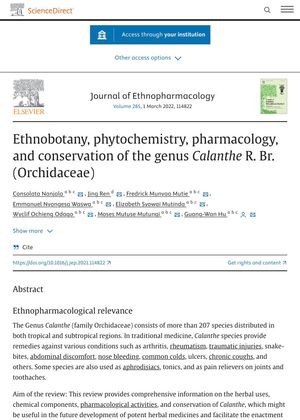TLDR Calanthe orchids have medicinal potential and contain 265 chemical compounds, but are underexplored.
The genus Calanthe, a type of orchid, has been recognized for its medicinal and scientific research values. It has been used in traditional medicine to treat various health conditions such as body swellings, traumatic injuries, joint pain, abdominal discomfort, and toothaches. Secondary metabolites from Calanthe species have shown potential in hair restoration, cancer treatment, anti-inflammatory and antiarthritic, antidiabetic and hepatoprotective activity, antiplatelet aggregation, and antibacterial and antifungal properties. A total of 265 chemical compounds from different chemical classes have been reported from Calanthe, which may be associated with these biological activities. However, many Calanthe species remain underexplored and poorly understood. The study reviewed research articles related to Calanthe species published between 1982 and 2021.
 3 citations
,
April 2021 in “Chemical & Pharmaceutical Bulletin”
3 citations
,
April 2021 in “Chemical & Pharmaceutical Bulletin” Extracts from the Calanthe discolor plant promote hair follicle growth and increase growth factor levels.
 136 citations
,
May 2019 in “Cells”
136 citations
,
May 2019 in “Cells” Stem cell therapy, particularly using certain types of cells, shows promise for treating hair loss by stimulating hair growth and development, but more extensive trials are needed to confirm these findings.
 89 citations
,
September 2010 in “Annual Review of Genomics and Human Genetics”
89 citations
,
September 2010 in “Annual Review of Genomics and Human Genetics” The document concludes that understanding the genes and pathways involved in hair growth is crucial for developing treatments for hair diseases.
 375 citations
,
February 2006 in “Journal of Cell Science”
375 citations
,
February 2006 in “Journal of Cell Science” The document concludes that the hair cycle is a complex process involving growth, regression, and rest phases, regulated by various molecular signals.
 520 citations
,
February 2001 in “Journal of Clinical Investigation”
520 citations
,
February 2001 in “Journal of Clinical Investigation” VEGF helps hair grow and determines follicle size by increasing blood vessel growth.
51 citations
,
November 1998 in “The journal of investigative dermatology/Journal of investigative dermatology” Beard cells, unlike scalp cells, produce growth factors in response to testosterone, which may explain differences in hair growth.
 3 citations
,
December 2021 in “Journal of medicinal plants”
3 citations
,
December 2021 in “Journal of medicinal plants” Halocnemum strobilaceum has potential health benefits and uses, including anticancer and antimicrobial properties.






